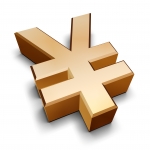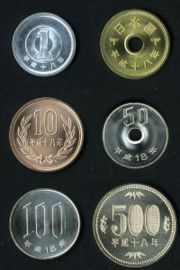JPY发表评论(0)编辑词条
The yen (sign: ¥; code: JPY) is the currency of Japan. It is the third most-traded currency in the foreign exchange market after United States dollar and the euro. It is also widely used as a reserve currency after the U.S. dollar, the euro and the pound sterling. As is common when counting in East Asia, large quantities of yen are often counted in multiples of 10,000 (man, 万) in the same way as values in Western countries are often quoted in thousands.
Pronunciation and etymology
The word en literally means "round object" in Japanese, as yuán does in Chinese, referring to the Imperial Chinese coins that were circular in shape and widely used in Japan up to the Tokugawa Period. In 1695, the character 元 (ghen), signifying "round or rounded") was placed on the obverse of copper coins.
The spelling and pronunciation "yen" is standard in English. This is because mainly English speakers who visited Japan at the end of the Edo era to the early Meiji era spelled words this way. In the 16th century, Japanese "e (エ)/we (ヱ)" had been pronounced [je] and Portuguese missionaries had spelled them that way. Some time thereafter, by the middle of the 18th century, "e/we" came to be pronounced [e] as in modern Japanese, although some regions retain the [je] pronunciation. Walter Henry Medhurst, who had not come to Japan and interviewed some Japanese in Batavia (Jakarta), spelled some "e"s as "ye" in his An English and Japanese, and Japanese and English Vocabulary (1830). In the early Meiji era, James Curtis Hepburn, following Medhurst, spelled all "e"s as "ye" in his A Japanese and English dictionary (1st ed. 1867). That was the first full-scale Japanese-English/English-Japanese dictionary, which had a strong influence on Westerners in Japan and probably prompted the spelling "yen". Hepburn revised all "ye"s to "e" in the 3rd edition (1886) in order to mirror the contemporary pronunciation, except "yen" and the particle "ye(へ)". These two were probably already fixed and have remained so ever since.
Coins
A silver one-yen coin of 1870
Japanese 10 yen coin (obverse) showing Phoenix Hall of Byōdō-in
Coins were introduced in 1870. There were silver 5, 10, 20 and 50 sen and 1 yen, and gold 2, 5, 10 and 20 yen. Gold 1 yen were introduced in 1871, followed by copper 1 rin, ½, 1 and 2 sen in 1873.
Cupronickel 5 sen coins were introduced in 1889. In 1897, the silver 1 yen coin was demonetized and the sizes of the gold coins were reduced by 50%, with 5, 10 and 20 yen coins issued. In 1920, cupro-nickel 10 sen coins were introduced.
Banknotes
The issuance of the yen banknotes began in 1872, two years after the currency was introduced. Throughout its history, the denominations have ranged from 10 yen to 10000 yen.
Before and during World War II, various bodies issued banknotes in yen, such as the Ministry of Finance and the Imperial Japanese National Bank.
The Allied forces also issued some notes shortly after the war. Since then, the Bank of Japan has been the exclusive note issuing authority. The bank has issued five series after World War II. Series E, the current series, consists of ¥1000, ¥2000, ¥5000, and ¥10,000.
Determinants of value
Beginning in December 1931, Japan gradually shifted from the gold standard system to the managed currency system.
The relative value of the yen is determined in foreign exchange markets by the economic forces of supply and demand. The supply of the yen in the market is governed by the desire of yen holders to exchange their yen for other currencies to purchase goods, services, or assets. The demand for the yen is governed by the desire of foreigners to buy goods and services in Japan and by their interest in investing in Japan (buying yen-denominated real and financial assets).
Since the 1990s, the Bank of Japan, the country's central bank, has kept interest rates low in order to spur economic growth. Short-term lending rates have responded to this monetary relaxation and fell from 3.7% to 1.3% between 1993 and 2008. Low interest rates combined with a ready liquidity for the Yen prompted investors to borrow money in Japan and invest it in other countries (a practice known as carry trade). This has helped to keep the value of the Yen low compared to other currencies.
日圆(円),又称作日元,其纸币称为日本银行券,是日本的官方货币,于1871年制定。日圆也经常在美元和欧元之后被当作储备货币。货币符号为“¥”,国际标准化组织ISO 4217订定其标准代号为JPY。日语罗马字写作Yen。
日文“円”字即为“圆”之略字(简体字),读为“えん”(en),并制订1円=100钱=1000厘。英称“Yen”;日元符号与人民币符号相近。国际标准化组织ISO 4217订定其标准代号为JPY。
日圆和人民币一样也是用¥来表示的,不过不同的是在数字后日圆的表示方法是加一个E字,比如:¥1400E
字源
“円”与中文的“圆”和韩国的“圆”为同源词,原本汉字与中文的“圆”写法相同。而现代的日语书写则采用简化的新字体(円),与中文普遍使用的“元”不同。拉丁货币符号(¥)与人民币类似,但中国有时也会使用“¥”(仅有一条线划过Y)符号。
在标准日语中,円念做“en”,但在英语中的标准拼法语发音则是“yen”,这是因为过去葡萄牙语转写所造成。“円”在日语中也代表著“圆形的物体”,和中文的“圆”意义相同,而在江户时代中国的硬币曾在日本被广泛使用。
历史
现在使用的日本货币单位“円”(日圆),是在1871年6月27日(明治4年5月10日)制定的。当年明治政府将一日圆的币值订定为与纯金1500毫克等值,并设有次一级的币值单位钱,相等於0.01日圆。现时日圆的汇率是1美元换116日圆。
根据考据,“日圆”这个“圆”字来自香港,因为当地最先把银圆由形容词变成量词,并在当地生产的银元刻上“香港壹圆”四字。这个变化从香港传到日本,亦成为了当地通货的名称。
流通货币
纸币由日本银行发行,日本国立印刷局制造,称为日本银行券
与“JPY,日元,货币”相关的词条
→如果您认为本词条还有待完善,请 编辑词条
词条内容仅供参考,如果您需要解决具体问题
(尤其在法律、医学等领域),建议您咨询相关领域专业人士。
0

同义词: 暂无同义词
关于本词条的评论 (共0条)发表评论>>










